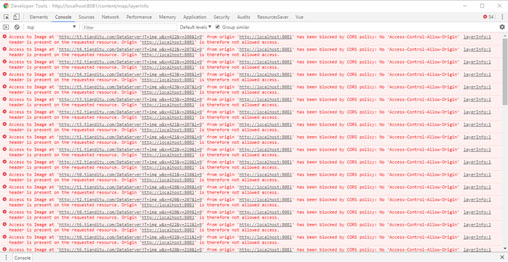
1. Error generation conditions
// 采用openlayers加载天地图
var layer = new ol.layer.tile({
source: new ol.source.xyz({
// crossorigin: 'anonymous', // 是否请求跨域操作
url: url // 天地图地址
})
});If the crossorigin attribute is not used, cross-domain problems will not occur, and generally this parameter will not be set.
The usage scenario of this parameter is as described on the official website:
the crossorigin attribute for loaded images. note that you must provide a crossorigin value if you are using the webgl renderer or if you want to access pixel data with the canvas renderer. see https://developer.mozilla.org/en-us/docs/web/html/cors_enabled_image for more detail.
Consult mdn documentation (https: //developer.mozilla.org/zh-cn/docs/web/html/cors_settings_attributes), you can find that crossorigin has two values

In the development process, often You need to run the development version locally and the production version on the server. When two versions are accessed in the same browser, cross-domain problems will occur if crossorigin is set, such as the error shown in the figure below,
has been blocked by cors policy: no 'access-control-allow -origin'header is present on the requested resource.

Note: This problem will only occur after crossorigin is set on Tiantu. It will not appear on Google basemap. The reason Yes:
The origin attribute of the request header returned by Tiantu is set to the currently visited IP, while the origin attribute of the Google base map is set to *, which means that systems with different IPs cache Google tiles in the browser You can still access the google basemap afterwards.
2. Error resolution method
2.1 Simple and violent method
The simple and violent solution is to clear the browser Cache images, at the same time, only view one of the systems. If you want to view another system, you must clear the browser image cache in advance
2.2 Delete the crossorigin attribute
Re-examine the map requirements and determine whether the crossorigin attribute is really needed. If not, this problem will not occur at all
2.3 nginx proxy solution
If The previous methods feel inappropriate, so use nginx as a proxy. It can solve cross-domain problems and cache tiles locally to speed up access.
Go directly to the configuration file.
#user nobody;
worker_processes 4;
#error_log logs/error.log;
#error_log logs/error.log notice;
#error_log logs/error.log info;
#pid logs/nginx.pid;
events {
worker_connections 1024;
}
http {
include mime.types;
default_type application/octet-stream;
#log_format main '$remote_addr - $remote_user [$time_local] "$request" '
# '$status $body_bytes_sent "$http_referer" '
# '"$http_user_agent" "$http_x_forwarded_for"';
#access_log logs/access.log main;
sendfile on;
#tcp_nopush on;
#keepalive_timeout 0;
keepalive_timeout 65;
#gzip on;
client_max_body_size 20m;
# 关键代码块1
proxy_temp_path ../proxy_cache/tianditu_temp;
proxy_cache_path ../proxy_cache/tianditu levels=1:2 keys_zone=cache_one:200m inactive=1d max_size=30g;
upstream tianditu_server {
server t0.tianditu.com weight=1 max_fails=2 fail_timeout=30s;
server t1.tianditu.com weight=1 max_fails=2 fail_timeout=30s;
server t2.tianditu.com weight=1 max_fails=2 fail_timeout=30s;
server t3.tianditu.com weight=1 max_fails=2 fail_timeout=30s;
server t4.tianditu.com weight=1 max_fails=2 fail_timeout=30s;
server t5.tianditu.com weight=1 max_fails=2 fail_timeout=30s;
server t6.tianditu.com weight=1 max_fails=2 fail_timeout=30s;
}
server {
listen 8088;
server_name localhost;
#charset koi8-r;
#access_log logs/host.access.log main;
# 关键代码块2
location /dataserver {
more_set_headers 'access-control-allow-origin: *';
add_header access-control-allow-headers x-requested-with;
add_header access-control-allow-methods get,post,options;
proxy_cache cache_one;
proxy_cache_key $uri$is_args$args;
proxy_pass http://tianditu_server/dataserver;
}
}
}Let’s explain the configuration file:
Key code block 1:
1. Use nginx upstream to configure a set of service addresses for load balancing Use, the effect is better than openlayers sequentially traverse t0 to t6
2, set the proxy cache temporary address and cache address, here you can use the relative path
Key code block 2
After matching the dataserver, you need to
1. Set the cross-domain header. Here a new nginx module-headers-more is used, which needs to be added when compiling nginx. If it is windows To use nginx, you can use the installation package of this website: https://openresty.org, which pre-compiles many nginx practical modules
2. Use proxy_pass to proxy the address to http://tianditu_server/dataserver address on, where tianditu_server is the name of the service group configured with load balancing above.
The above is the detailed content of How to use nginx proxy map as cache to solve cross-domain problems. For more information, please follow other related articles on the PHP Chinese website!
 nginx restart
nginx restart
 Detailed explanation of nginx configuration
Detailed explanation of nginx configuration
 Detailed explanation of nginx configuration
Detailed explanation of nginx configuration
 What are the differences between tomcat and nginx
What are the differences between tomcat and nginx
 How to use each function in js
How to use each function in js
 Introduction to the levels of Python exams
Introduction to the levels of Python exams
 Usage of between function
Usage of between function
 What should I do if English letters appear when I turn on the computer and the computer cannot be turned on?
What should I do if English letters appear when I turn on the computer and the computer cannot be turned on?




